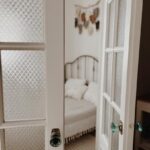Are you wondering, “How should I decorate my home office” to boost productivity and create an inspiring work environment? Designing a home office that fosters creativity and efficiency is crucial for those who work remotely or run a business from the comfort of their own space.
In this article, we’ll explore various aspects of home office decor, from assessing your space and choosing the right color scheme to incorporating personal touches and maximizing organization. By following these tips, you can transform your home office into a functional and aesthetically pleasing workspace that enhances your overall productivity.
When it comes to setting up a home office, it’s essential to consider factors such as layout, functionality, color scheme, furniture selection, storage solutions, lighting, and personalization. Whether you’re working with a small corner in the living room or have a dedicated room for your office, taking the time to carefully plan and decorate your workspace can make all the difference in your daily productivity.
From creating a layout that maximizes efficiency to selecting furniture pieces that combine practicality and style, every detail plays a role in shaping an inspiring work environment.
In addition to focusing on practicality and functionality, infusing your personality and preferences into the decor can also contribute to a more enjoyable work experience. Adding personal touches like artwork, photos, or meaningful mementos can create a sense of comfort and familiarity in your home office.
Furthermore, finding the perfect balance of natural and artificial light as well as incorporating greenery and natural elements can further enhance the ambiance of your workspace. Throughout this article, we’ll explore different ways to achieve both functionality and aesthetic appeal within your home office decor while also providing budget-friendly tips for those looking to decorate without breaking the bank.
Assessing Your Space
When it comes to setting up a home office, one of the first things to consider is the layout and functionality of the space. Whether you have a dedicated room for your office or a small corner in a multipurpose area, it’s important to assess the available space to make the most of it. Start by taking measurements and noting the location of power outlets, windows, and any other architectural features that may impact the layout.
Consider how you will be using the space on a day-to-day basis. Will you need ample desk space for spreading out documents and working on multiple projects at once? Are you planning to meet with clients or colleagues in your home office, requiring extra seating? Thinking about these functional aspects will help determine how to best arrange furniture and organize supplies for maximum efficiency.
In addition to practical considerations, it’s also important to think about how you want the space to feel. Do you prefer a more open and airy environment or do you thrive in cozy, enclosed spaces? This will help guide decisions on furniture arrangement, storage solutions, and overall aesthetics. Taking into account both functionality and personal preference is key in creating a home office that truly works for you.
| Space Assessment Considerations | Key Takeaways |
|---|---|
| Measurements and architectural features | Ensure furniture fits well within the space |
| Day-to-day use requirements | Determine desk size, seating needs, and storage solutions |
| Aesthetic preferences | Create an environment that feels comfortable and inspiring |
Choosing the Right Color Scheme
When it comes to decorating your home office, choosing the right color scheme is key to creating an inspiring and energizing environment that promotes productivity. The colors you choose can have a significant impact on your mood, focus, and overall well-being while working. So, how should I decorate my home office with the perfect color scheme? Here are some tips to help you decide:
First, consider the type of work you’ll be doing in your home office. If you need to stay focused and concentrated for long periods, consider using calming and soothing colors such as soft blues or greens. These colors can help reduce stress and create a sense of peace and tranquility. On the other hand, if your work requires creativity and innovation, opt for more stimulating and energizing colors like yellow or orange to boost inspiration.
Another important factor to consider when choosing the right color scheme for your home office is natural light. If your workspace receives plenty of natural light, you can experiment with darker or bolder colors without making the room feel cramped or overwhelming. However, if your office lacks natural light, stick to lighter shades to make the space feel more open and airy.
Lastly, don’t be afraid to add pops of vibrant or accent colors to inject personality and energy into your home office. Whether it’s through artwork, decorative accessories, or furniture pieces, incorporating these touches can add visual interest and keep your workspace from feeling too sterile or bland.
By carefully selecting the right color scheme for your home office based on your work needs and natural lighting conditions, you can create a space that not only looks aesthetically pleasing but also promotes productivity and overall well-being. Consider these tips as you think about how should i decorate my home office with the perfect colors for a successful work environment.
Essential Furniture and Decor
When it comes to creating a productive home office, choosing the right furniture and decor is essential. The right pieces can not only improve functionality but also add style and personality to your workspace. Here are some tips for selecting practical and stylish furniture and decor for your home office.
Functionality First
When selecting furniture for your home office, it’s important to prioritize functionality. Consider the specific needs of your work and choose pieces that will support those needs. For example, if you require a large work surface, opt for a spacious desk. If you need ample storage space, invest in filing cabinets or shelves. By prioritizing functionality, you can ensure that your home office is equipped to support your productivity.
Style and Aesthetics
While functionality is key, style and aesthetics are also important considerations when selecting furniture and decor for your home office. Choose pieces that align with your personal style and preferences, as this will help create a space that feels inviting and inspiring. Consider elements such as color, material, and design when making furniture choices. Additionally, don’t forget about decor items such as artwork, plants, or decorative accessories that can add personality and visual interest to your workspace.
Quality Over Quantity
When decorating your home office, it’s better to invest in high-quality pieces that will stand the test of time rather than buying cheap, short-lived options. Quality furniture not only adds durability but also contributes to the overall aesthetic appeal of the space. Look for well-built desks, chairs, and storage solutions that will serve you well for years to come.
By focusing on functionality, style, aesthetics, and quality when selecting furniture and decor for your home office, you can create a workspace that is both practical and visually appealing. Remember to consider your specific work needs and personal preferences as you make decisions to ensure that your home office reflects who you are while supporting optimal productivity.
Maximizing Storage and Organization
When it comes to designing a home office, one of the most important aspects to consider is how to maximize storage and organization. A cluttered and disorganized workspace can lead to decreased productivity and increased stress, so it’s essential to prioritize this aspect of your design. Here are some tips on how to keep clutter at bay in your home office.
First and foremost, assess your storage needs based on the type of work you do. If you have a lot of paperwork, files, or office supplies, investing in a filing cabinet or a set of sturdy shelves can help keep everything organized and easily accessible. Utilize drawer organizers, file folders, and desktop trays to create designated spaces for different items.
Consider furniture pieces that offer built-in storage solutions, such as desks with drawers or bookshelves with cabinets. This will allow you to keep essential items within arm’s reach while maintaining a clean and tidy workspace. Additionally, wall-mounted shelves or vertical storage units can make use of vertical space and free up valuable floor space.
Incorporating organizational systems such as wall-mounted bulletin boards, corkboards, or magnetic boards can also help keep track of important notes, reminders, and schedules without creating visual clutter on your desk. By implementing these storage and organization strategies into your home office design, you can create a functional and efficient workspace that promotes productivity and creativity while keeping clutter at bay.
Incorporating Personal Touches
When it comes to decorating your home office, incorporating personal touches can make a big difference in creating a space that truly reflects your style and enhances your comfort. Whether you’re working from home full-time or just need a dedicated area for occasional tasks, adding personal touches can help make the space feel more inviting and inspiring. Here are some ideas for adding personality and comfort to your home office:
- Displaying Personal Mementos: Consider adding framed photos, artwork, or sentimental objects that bring you joy and remind you of the things that matter most to you.
- Utilizing Inspirational Quotes: Decorate your workspace with inspirational quotes or affirmations that resonate with you, helping to motivate and inspire you as you work.
- Adding Comfortable Elements: Incorporate cozy elements like throw pillows, a soft rug, or a comfortable chair to make your home office feel more inviting and comfortable.
In addition to these ideas, think about incorporating items that reflect your hobbies and interests. Whether it’s displaying books related to your favorite topics or incorporating decor items that showcase your passion for travel, adding these personal touches can help create a work environment that feels uniquely yours.
Ultimately, the key to incorporating personal touches into your home office is to create a space that not only supports productivity but also makes you feel happy and comfortable while working. Take the time to assess what brings you joy and how you can integrate those elements into your workspace to truly make it your own. By doing so, you’ll be able to create a home office that is both functional and reflective of your individuality.
Lighting
When it comes to designing a home office, one of the most important factors to consider is the lighting. Finding the perfect balance of natural and artificial light can significantly impact your productivity and overall well-being. Here are some tips on how to effectively light your home office:
1. Assess your space: Before choosing your lighting setup, take a look at your home office and determine where the natural light sources are located. Consider positioning your desk or work area near a window to take advantage of natural sunlight.
2. Choose the right artificial lighting: In addition to natural light, you’ll also need artificial lighting to illuminate your workspace, especially during evening hours or on cloudy days. Invest in a good quality desk lamp or floor lamp that provides adequate task lighting, as well as ambient lighting for the entire room.
3. Dimmer switches: Installing dimmer switches in your home office allows you to control the brightness of artificial lights, creating a flexible and customizable environment that suits different tasks and moods throughout the day.
4. Avoid glare and shadows: Positioning lights behind or directly above your computer screen can create glare, which can cause eye strain and discomfort. Instead, place lights off to the sides or use adjustable shades to direct light where it’s needed without causing glare.
By carefully considering how you should decorate your home office with proper lighting, you can create a workspace that is both functional and aesthetically pleasing while promoting productivity and comfort.
Greenery and Natural Elements
Bringing natural elements into your home office can have a significant impact on the overall atmosphere and productivity of the space. Research has shown that incorporating plants and natural elements into a workspace can help reduce stress, boost creativity, and increase overall well-being. So, how should I decorate my home office with greenery and natural elements?
First, consider adding low-maintenance indoor plants such as succulents, snake plants, or pothos. These plants not only add visual appeal to your workspace but also require minimal care, making them perfect for busy individuals. Additionally, consider incorporating natural materials such as wood, stone, or cork into your furniture or decor to bring warmth and earthiness into the environment.
In terms of placement, strategically position your greenery and natural elements near your primary work area to create a sense of calm and tranquility. Consider placing a small potted plant on your desk or adding a larger plant in a corner to fill empty spaces while providing a breath of fresh air.
When it comes to decor, look for artwork or prints featuring nature-inspired themes such as landscapes, botanicals, or wildlife to further enhance the natural ambiance of your home office.
| Benefit | Example |
|---|---|
| Reduced stress | Plants can help reduce stress levels |
| Boost creativity | Natural elements can enhance creativity in the workspace |
| Increase well-being | Natural elements contribute to an overall sense of well-being |
Budget-Friendly Tips and DIY Ideas
Decorating your home office on a budget doesn’t mean you have to sacrifice style or functionality. With some creativity and resourcefulness, you can create a workspace that is both practical and visually appealing without breaking the bank. Here are some budget-friendly tips and DIY ideas for decorating your home office:
Repurpose Existing Furniture
One of the easiest ways to save money when decorating your home office is to repurpose existing furniture. Look around your house for items that can be converted into functional pieces for your workspace, such as an old bookshelf that can be used for storage or a table that can be turned into a desk. With a fresh coat of paint or some new hardware, these items can take on a new life in your home office.
Shop Secondhand
Shopping for furniture and decor at thrift stores, garage sales, and online marketplaces can yield some great finds at affordable prices. You’d be surprised at what you can find with a little patience and perseverance. Look for quality pieces that can be spruced up with a little DIY love, such as sanding down and refinishing an old wooden desk or reupholstering a vintage chair.
DIY Decor Projects
Get creative with DIY decor projects to personalize your home office without spending a fortune. Create your own artwork by framing fabric or wallpaper samples, or make custom shelving using inexpensive materials like crates or plywood. Upcycling old jars or cans into stylish desk organizers is another simple and cost-effective way to add personality to your workspace.
By incorporating these budget-friendly tips and DIY ideas, you can decorate your home office in a way that reflects your personal style and enhances productivity without straining your wallet. With a little creativity and resourcefulness, you can create a functional and aesthetically pleasing workspace that inspires you to do your best work every day while staying within budget.
Conclusion
In conclusion, decorating a home office is not just about making it visually appealing, but also creating a space that enhances productivity and inspires creativity. When considering how to decorate your home office, it’s important to assess your space and determine the layout and functionality that best suits your needs.
Choosing the right color scheme can go a long way in creating an inspiring and energizing environment, so take the time to select colors that help you focus and feel motivated.
Additionally, incorporating personal touches into your home office can make the space feel more comfortable and personalized. Whether it’s adding artwork, photographs, or meaningful decor items, these personal touches can help create a space that truly feels like your own. Lighting is also crucial in a home office, so find the perfect balance of natural and artificial light to help reduce eye strain and boost your mood.
Lastly, if you’re working with a budget, there are plenty of budget-friendly tips and DIY ideas for decorating your home office without breaking the bank. From upcycling old furniture to adding greenery for a touch of nature, there are many ways to create a functional and aesthetically pleasing home office without spending a fortune.
By bringing together all these elements – from layout and color scheme to personal touches and budget-friendly decor – you can create a home office that not only looks great but also helps you stay focused, productive, and inspired.
Frequently Asked Questions
How Can I Make My Home Office Look Good?
To make your home office look good, you can start by decluttering and organizing the space. Use stylish and functional furniture, add some decorative elements like artwork or plants, and ensure good lighting to create a pleasant and productive environment.
How Can I Make My Office Look Nice?
Making your office look nice involves paying attention to details such as the color scheme, furniture choice, and organization. Consider using calming colors, comfortable seating, and personal touches like family photos or souvenirs to add warmth to the space.
How Can I Professionally Decorate My Office?
When professionally decorating your office, focus on creating a cohesive and polished look. Invest in high-quality furniture that is both comfortable and aesthetically pleasing. Choose sophisticated decor such as artwork or sculptures that reflect your personal style while still maintaining a professional atmosphere. Additionally, consider how lighting can enhance the overall ambiance of the space.

I’m thrilled to be your companion on this exciting journey through the world of home decor and design. With a passion for turning houses into homes and a keen eye for the finer details, I’m here to help you transform your living spaces into beautiful, functional, and meaningful havens.





